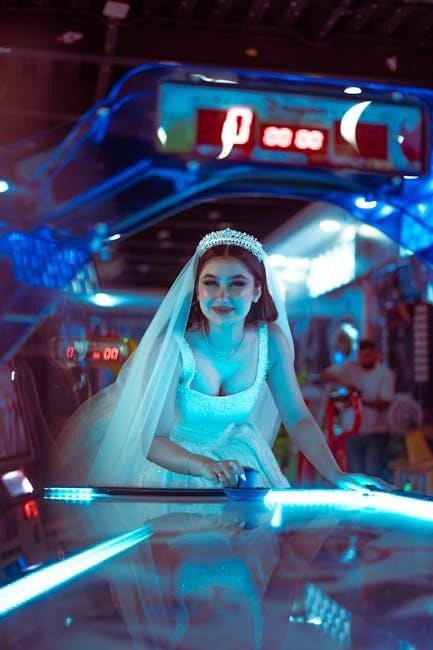Welcome to this comprehensive guide exploring the “Game of Tiaras Script PDF,” a captivating theatrical masterpiece designed for theater enthusiasts, literature lovers, and drama practitioners alike.

1.1 Overview of the Play
The “Game of Tiaras” is a captivating theatrical production that delves into themes of power, loyalty, and identity. Set in a fictional kingdom, the play follows a royal court where alliances are tested, and ambition reigns supreme. Through a blend of drama and humor, the story explores the intricate dynamics between rulers and subjects, highlighting the consequences of betrayal and the pursuit of power. The script is designed to engage audiences with its rich dialogue, complex characters, and a plot filled with twists and turns. This modern take on classic royal intrigue offers a fresh perspective on timeless human struggles and aspirations.
1.2 Significance of the Script

The “Game of Tiaras Script PDF” holds immense value for both educational and entertainment purposes. It serves as a powerful tool for students and drama practitioners to analyze character development, dialogue, and plot structure. The script provides insight into the art of storytelling, offering lessons on pacing, conflict resolution, and thematic exploration. For audiences, it delivers an engaging narrative that explores universal themes, making it relatable and thought-provoking. Additionally, the script’s accessibility in PDF format allows for easy distribution and study, making it a valuable resource for theater productions, academic research, and personal enjoyment. Its significance lies in its ability to inspire creativity and foster deeper understanding of dramatic literature.

1.3 Purpose of the Article
This article aims to provide a detailed exploration of the “Game of Tiaras Script PDF,” offering insights into its plot, characters, and themes. It serves as a guide for readers to understand the script’s structure, analyze its dramatic elements, and appreciate its artistic value. The purpose is to assist theater enthusiasts, students, and practitioners in gaining a deeper understanding of the play, facilitating both academic study and practical production. By breaking down key components, the article helps readers engage with the script more effectively, whether for analysis, performance, or personal enjoyment. Its goal is to enhance comprehension and appreciation of this theatrical work.

Understanding the Script
Dive into the world of “Game of Tiaras” by examining its historical backdrop, thematic depth, and structural design. This section lays the groundwork for analyzing the script’s complexity and artistry.
2.1 Historical Context of the Play
The “Game of Tiaras” script is set in a fictional medieval kingdom, drawing inspiration from historical power struggles and royal intrigues. The play mirrors real-world dynastic conflicts, such as the Wars of the Roses, where ambition and loyalty were constantly tested. By blending historical accuracy with creative liberties, the script crafts a compelling narrative that explores themes of authority, betrayal, and identity. The historical backdrop enriches the characters’ motivations, making their struggles relatable and timeless. This section provides essential context to understand the play’s setting and its relevance to both historical and contemporary audiences.
2.2 Key Themes and Motifs
The “Game of Tiaras” script explores themes of power and authority, as characters navigate royal hierarchies and political intrigue. Loyalty and betrayal are central, driving the plot’s twists and character dynamics. The struggle for identity and self-discovery is also prominent, as protagonists confront their roles and ambitions. Motifs such as crowns symbolize legitimacy and control, while mirrors reflect hidden truths and inner conflicts. The interplay of light and darkness underscores moral dilemmas and the duality of human nature. These themes and motifs create a rich, layered narrative that engages audiences and invites deeper reflection.
2.3 Structure and Format of the PDF
The “Game of Tiaras Script PDF” is meticulously structured for clarity and readability. The document begins with a title page, followed by a table of contents that outlines acts, scenes, and key sections. Each act is divided into scenes, with clear headings indicating settings and character entrances. Dialogue is formatted with character names in bold, making it easy to follow. Stage directions are italicized and placed in parentheses for distinction. The PDF also includes appendices with production notes, glossaries, and historical context, enhancing its utility for both performers and scholars. The clean layout ensures a seamless reading experience.
Key Elements of the Script
The script’s core elements include a compelling plot, dynamic characters, engaging dialogue, and detailed stage directions, all woven together to create a theatrical experience rich in depth and emotion.
3.1 Plot Summary
The “Game of Tiaras Script PDF” unfolds as a captivating tale of ambition, power, and transformation. Centered around a magical tiara, the story explores the lives of rival characters vying for control. As alliances form and tempers flare, the tiara’s true power is revealed, forcing each character to confront their inner demons. The plot twists through betrayal, redemption, and unexpected alliances, culminating in a climactic showdown that reshapes their destinies. With themes of identity and morality woven throughout, the narrative delivers a compelling journey of self-discovery and the consequences of desire. The script’s intricate plot ensures a dramatic and thought-provoking experience for audiences and performers alike.
3.2 Character Analysis
The “Game of Tiaras Script PDF” features a diverse cast of characters, each with unique personalities and motivations. The protagonist, a determined and ambitious leader, drives the story forward with their quest for power and identity. In contrast, the antagonist, cunning and manipulative, seeks to undermine their rivals through deceit and strategy. Supporting characters, including loyal allies and morally conflicted figures, add depth to the narrative, exploring themes of loyalty, betrayal, and self-discovery. The script delves into the psychological and emotional journeys of its characters, highlighting their growth and transformations. This intricate character development enriches the play’s dramatic tension and emotional resonance.
3.3 Dialogue and Language Style
The dialogue in the “Game of Tiaras Script PDF” is crafted to reflect the characters’ personalities, motivations, and the play’s themes. The language is sharp, witty, and often layered with subtext, allowing actors to convey complex emotions. Conversations are dynamic, driving the plot forward while revealing deeper character traits. The script employs metaphors, sarcasm, and poetic expressions to enhance dramatic tension. Formal and informal speech patterns contrast, highlighting social hierarchies and relationships. The dialogue also incorporates symbolic language, mirroring the play’s motifs of power, loyalty, and identity. This stylistic diversity makes the script engaging for both performers and audiences, enriching the storytelling experience.

Themes in “Game of Tiaras”
The “Game of Tiaras” explores themes of power, loyalty, betrayal, identity, and self-discovery, weaving them into a compelling narrative that captivates and challenges its audience.
4.1 Power and Authority
The “Game of Tiaras” delves deeply into the themes of power and authority, exploring how characters navigate dominance, control, and leadership. The script portrays the relentless pursuit of power, highlighting its transformative and often corrupting influence. Through intricate character dynamics, the play examines how authority is both wielded and contested, revealing the complexities of hierarchical structures. Key scenes illustrate the tension between rightful leadership and the abuse of power, while dialogues expose the moral dilemmas faced by those in positions of authority. This theme is central to the narrative, offering a nuanced exploration of power’s dual nature and its impact on individuals and societies.

4.2 Loyalty and Betrayal
Loyalty and betrayal are central themes in “Game of Tiaras,” driving the plot and shaping character relationships. The script intricately portrays how loyalty is tested, often leading to betrayal, which in turn sparks conflict and transformation. Characters struggle with allegiance to their ideals, loved ones, and power structures, while others exploit trust for personal gain. Pivotal moments of betrayal reshape alliances and destinies, highlighting the emotional and moral complexities of these actions. The play underscores the devastating consequences of betrayal, yet also reveals its potential to provoke growth and resilience. Loyalty and betrayal are timeless themes that resonate deeply, reflecting the human condition.
4.3 Identity and Self-Discovery
Identity and self-discovery are profound themes in “Game of Tiaras,” as characters navigate their roles, ambitions, and inner truths. The script delves into how individuals grapple with societal expectations, personal desires, and the masks they wear. Through their journeys, characters uncover hidden strengths, confront insecurities, and redefine their purposes. This theme is particularly evident in the protagonist’s evolution, as they question their place in the world and ultimately embrace their authentic selves. The play highlights the universal struggle of self-discovery, offering a deeply relatable exploration of what it means to find one’s true identity amidst chaos and uncertainty. This theme resonates powerfully with audiences.
Stage Directions and Production Notes
“Game of Tiaras” provides detailed stage directions, guiding set design, lighting, sound, and costumes. These elements enhance storytelling, creating an immersive experience that captivates and engages audiences effectively.

5.1 Set Design and Props
The set design for “Game of Tiaras” transports audiences to a regal yet mysterious world. Grand thrones, opulent tapestries, and intricate props like royal scepters and crowns create an authentic royal court atmosphere. The stage transitions seamlessly between indoor and outdoor settings, such as the grand hall and the enchanted forest, using movable panels and clever lighting. Props are carefully chosen to reflect the characters’ status and motivations, while symbolic items like the magical tiara serve as central plot devices. Attention to detail ensures the set and props enhance the story’s emotional depth and visual appeal, immersing the audience in the narrative.
5.2 Costume and Makeup
Costumes in “Game of Tiaras” are meticulously designed to reflect the characters’ social status, personality, and role in the story. Royal attire features rich fabrics, intricate embroidery, and regal colors, while commoners wear simpler, earth-toned garments. Makeup enhances the actors’ expressions, distinguishing between noble grace and villainous cunning. Prosthetics and wigs are used to create distinct looks, such as aging characters or mythical beings. Accessories like jewelry and belts add depth, symbolizing power or hidden motives. The interplay of costumes and makeup ensures each character’s identity is vividly portrayed, enriching the play’s visual and emotional impact for the audience.
5.3 Sound and Music
Sound and music in “Game of Tiaras” are integral to creating an immersive theatrical experience. The script incorporates sound effects to evoke specific moods, such as the bustling of a market or the eerie silence of a forest. Music plays a pivotal role in heightening emotions, with orchestral scores accompanying grand entrances and tense confrontations. Background music subtly underscores key moments, while character-specific themes help define their personalities. The script also includes cues for sound transitions, ensuring seamless shifts between scenes. These auditory elements are carefully detailed in the PDF, offering directors a clear blueprint for enhancing the play’s emotional and dramatic impact.

Detailed Scene Analysis
This section delves into pivotal moments from the “Game of Tiaras” script, analyzing their dramatic impact, character interactions, and narrative significance to enrich the storytelling experience.
6.1 Opening Scene
The opening scene of “Game of Tiaras” sets the tone with a grand ballroom setting, introducing the protagonist, Lady Victoria, amidst a lavish celebration. The atmosphere is tense, as whispers of political intrigue ripple through the crowd. Lady Victoria’s dialogue reveals her internal conflict between duty and desire, immediately engaging the audience. The stage directions emphasize the opulence of the set, with chandeliers and intricate costumes, contrasting the darkness lurking beneath the surface. This scene expertly establishes the central conflict and hooks the audience, foreshadowing the power struggles and personal dilemmas that will unfold. It is a masterful blend of drama and spectacle.
6.2 Climax and Resolution
The climax of “Game of Tiaras” unfolds as Lady Victoria confronts the mastermind behind the plot to seize the throne, revealing a shocking betrayal. Tension peaks in a dramatic showdown where alliances are broken, and truths are exposed. The resolution ties together loose ends, with Lady Victoria emerging victorious but scarred by the cost of power. The final scene reflects on the sacrifices made, leaving the audience contemplating the true price of ambition. The resolution is both poignant and satisfying, wrapping up the narrative while lingering in the minds of the viewers long after the curtain falls. It is a powerful conclusion to the story.

Character Development
Character development in “Game of Tiaras” is intricate, with each character evolving through dialogue, actions, and interactions, revealing deeper motivations and emotional growth throughout the play.
7.1 Protagonist Journey
The protagonist’s journey in “Game of Tiaras” is a compelling exploration of transformation and resilience. From naivety to empowerment, the protagonist navigates intricate political and emotional landscapes, facing pivotal choices that define their character. Through trials and setbacks, they uncover hidden strengths and confront their vulnerabilities, evolving into a formidable force. Their growth is marked by moments of self-doubt, courage, and ultimate triumph, making their journey a central emotional anchor of the play. This arc not only drives the plot but also underscores themes of identity and power, leaving a lasting impact on the audience and the story’s outcome.
7.2 Antagonist Motivations
The antagonist in “Game of Tiaras” is driven by a complex mix of ambition, revenge, and a deep-seated need for validation. Their motivations stem from a history of betrayal and overlooked potential, fueling a relentless pursuit of power. They manipulate others through charm and deceit, masking their true intentions behind a veneer of loyalty. Their actions are calculated, often ruthless, yet justified in their mind as necessary to claim what they believe is rightfully theirs. This multifaceted character challenges the protagonist while embodying the play’s themes of power and betrayal, making them a compelling and formidable force in the narrative.
The “Game of Tiaras Script PDF” offers a rich exploration of drama, politics, and personal struggles, providing a compelling narrative for both entertainment and educational purposes. Through its intricate characters, themes, and stagecraft, the play delves into universal human experiences such as power, loyalty, and identity. This script is a valuable resource for theater enthusiasts, educators, and performers, offering insights into the craft of storytelling and character development. Its themes resonate deeply, making it a timeless piece for audiences seeking meaningful drama. Ultimately, “Game of Tiaras” leaves a lasting impression, inviting reflection on its complex characters and their enduring struggles.
